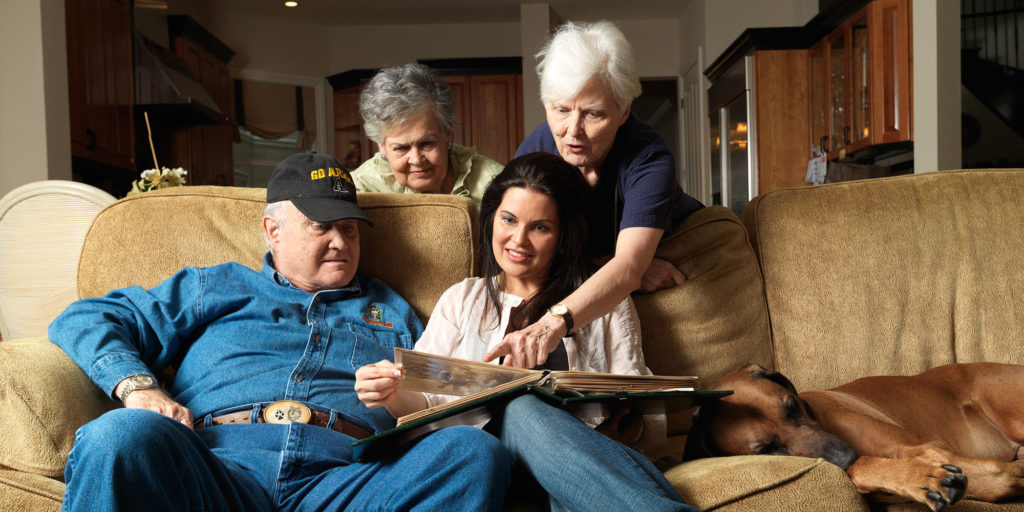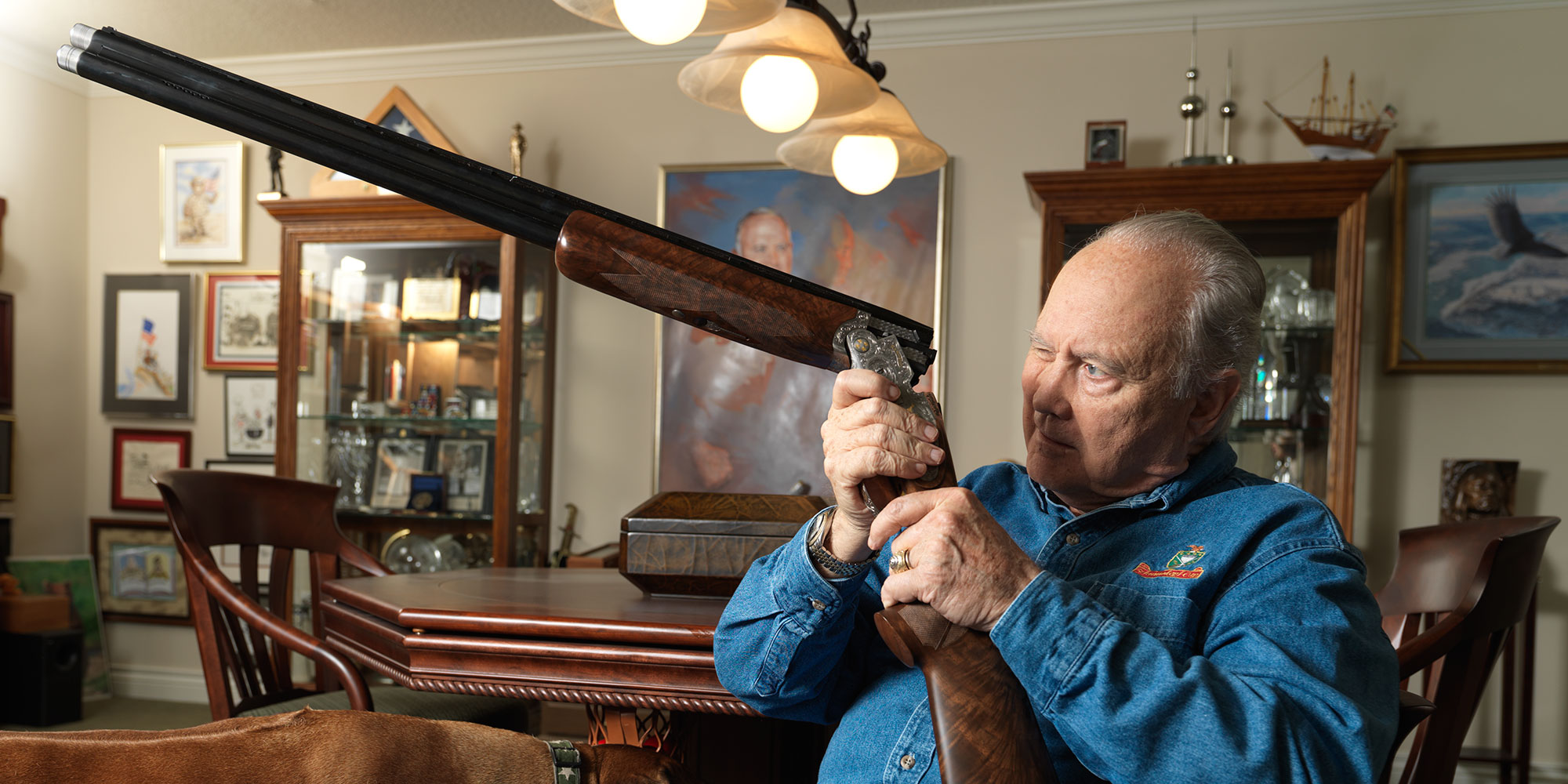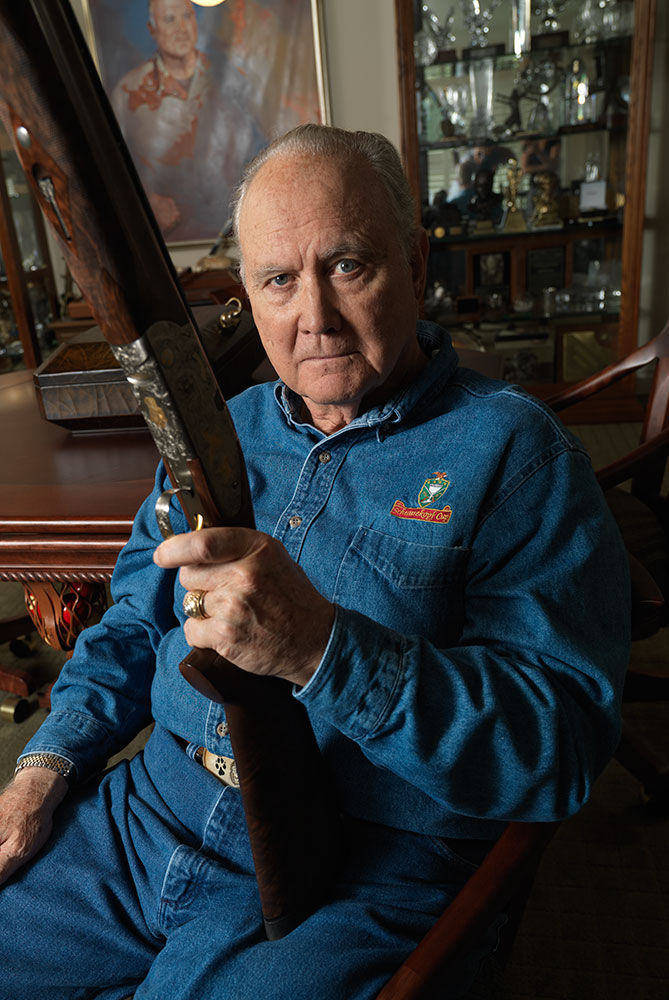As General H. Norman Schwarzkopf shakes my hand, it is nothing less than a bear grip.
“Norman doesn’t let go of the pretty girls,” his sister Sally jokes.
On the day before his 75th birthday, a stack of unopened envelopes occupy the kitchen table, birthday cards and well wishes that Brenda, the general’s wife of 41 years, won’t let him open until the calendar strikes Aug. 22. Sally flew in from Bethesda, Maryland, for the occasion.
“I had to come down for his birthday,” she says. “They bumped me to first class,” she adds, affectionately patting her baby brother’s arm, “all because of him.”
The family plans to celebrate by laying low, maybe baking a cake, watching some TV on the couch then heading to The Capital Grille for dinner.
“We lead a quiet life,” Sally says.
In the next room, beneath a nook of faux sky ceiling, Schwarzkopf’s sporting clays gear is carefully laid out on the dining room table: a hunter green shooting vest with his name woven into it, a selection of hats (“Everybody wants to give him hats,” says Brenda. “In Colorado, it’s cowboy hats.”), and a custom shotgun. He has plenty of guns to choose from, but he selected this one to be photographed.
“It was a gift,” he says, from the folks at Remington.
A few minutes later, before heading outside to take some shots, Schwarzkopf’s youngest daughter Jessica, 37, mistakenly refers to the shotgun as a rifle. He looks at her sideways.
“Did you say rifle?” he asks.
An avid outdoorsman, hunter and shooter for most of his life, Schwarzkopf honed in on sporting clays after returning nearly 20 years ago from the Gulf War, where he served as Commander in Chief of U.S. Central Command. Often described as “golf with a shotgun,” sporting clays is a form of clay pigeon shooting that involves shooting targets at multiple stations. Saucer-shaped “birds” or “targets,” usually bright orange, are launched in a variety of trajectories, angles, speeds, elevations and distances, mimicking the movements of birds and animals. Initially, he saw it as a great way to “tune himself up” for bird shooting, but the practice quickly became a passion.
Schwarzkopf’s father, a military man and superintendent of the New Jersey State Police Department (he was a lead investigator in the infamous Lindbergh kidnapping case), taught him to shoot early on in life. His first gun was the Daisy Red Ryder, a BB gun, the kind Ralphie asks Santa for in the movie “A Christmas Story.” While growing up, the family had a pistol range in the basement. When he was 12, his father and a few friends took him hunting in the Iranian desert; they were living in Tehran at the time while his father was on assignment. He shot a gazelle, his first kill. Since then, he has tracked a Dall sheep through the mountains of Alaska for days on foot, come face to face with a lion on a hunting safari trip in Africa, had his camping site threatened by wolves, skied alongside coyotes and been dropped off alone for a trek through the Alaskan wilderness. Brenda says when she picked him up one week later, he was smiling, and his feet were bleeding.
Pennsylvania, Colorado, New Jersey, Florida, Georgia, Washington, Alabama, Texas, Africa, Spain, England, Germany. Schwarzkopf can tell you a story — or two or three — from each place, but Alaska is where his true love for the outdoors took root. It’s also where he got the nickname “Bear,” which probably came from “being big and burly,” he jokes.
“I’ve also been known to growl like a grizzly and can be a teddy bear at times,” he says with a chuckle.
By the time he was 10, Schwarzkopf could identify practically every bird in New Jersey. Today, you name it and he’s probably hunted it: goose, dove, duck, quail, partridge, pheasant, turkey. Sporting clays was the perfect way to fine-tune his art.
Three days after returning home from Desert Storm a hero in 1991, having captured America’s heart and enduring respect, he and his executive officer Col. B.B. Bell went out to shatter a few clays. The sport is also a way for the general to bond with his son, Christian.
“After the war, it was almost every Saturday and Sunday,” Schwarzkopf says. Once, he shot clays with the King of Spain.
Fresh air, coupled with the deafening sound of a fired shotgun and its echo against the landscape, has a way of putting Schwarzkopf at ease. The weight of the stock on his shoulder, walking the trails between stations, the rush of ordering, “Pull!” and that moment when a shot strikes the target and it explodes to pieces in mid-air. Ask him his record score and the left-handed shooter will tell you: Perfect.
“Depending on the course, I’ve been 30 for 30 and 50 for 50 when I was really hot, which is a great feeling when you’re going up against an opponent,” he says.
His intensity and competitive spirit on the course are never a question — when Schwarzkopf aims and fires he intends to “kill,” sportsman speak for a hit — and he is a longtime advocate of opening the sport up to everyone, Tampa Bay residents in particular.
“It used to be that the only outdoor shooting available was on private courses,” he says.
Part of his mission has been to make the sport more accessible so people can learn it and enjoy it.
“He was instrumental in getting [the course] up and running out at MacDill,” says Lynn Williams, Schwarzkopf’s chief of staff and right-hand woman for more than 20 years. “When they opened up the new range at Deer Creek [Sporting Clays of Tampa], he was one of the founding members.”
Clay shooting was even an activity at his oldest daughter Cindy’s destination-wedding weekend in Cabin Bluff, Georgia. For better or worse, the general loves his clays. Of course, he loves his family even more.
Brenda remembers the first time she saw her husband. She was 26 and a flight attendant for the former TWA Airlines. It was a Saturday, and she had attended a U.S. Military Academy football game at the school’s home in West Point, New York. At a postgame dinner in the Officer’s Club, friends told her there was a young man they thought she should meet, and they asked would she mind if they introduced the two. “That would be great,” she said. That’s when she caught a glimpse of the 6-foot-3, blue-eyed man from Trenton, New Jersey, she silently wished him to be the one. He was.

Sitting in the dining room of their Tampa home on Aug. 21, Brenda talks about how the family moved 28 times — a number she says is fairly average for Army families — before settling in Tampa. She talks about the handmade punch bowl on the dining room table, the one his mother gave them as a wedding gift, how its fragile nature “scared her to death.” Thinking about it now, she takes it off the table and places it somewhere safer. She shows me their wedding album. The bride, her groom and three bridesmaids all wore white. She found her wedding gown in New York for $125 and her bridesmaids’ dresses for $35 each. She talks about one of her most memorable moments, the time her Norm was the guest of honor for the Indy 500, where Mario Andretti drove them around the track.
“I can still hear it. It was absolutely overwhelming,” she says, closing her eyes and bringing her hand to her temple, of the noise the crowd made that afternoon. “I’ve never heard such a roar.”
There has been a lot of roaring throughout this “Bear’s” 75 years.
The roar of animals he has hunted and shared the wild with, the roar of planes and bullets and orders barked, the roars of laughter with friends, fellow soldiers and family, and the roaring of decades gone by too fast.
The general doesn’t like to talk about his place in history, his legacy. He won’t call himself a hero. Yet, there is no doubt in America’s mind that is exactly what he is. A hero. An icon. In a life such as Gen. H. Norman Schwarzkopf’s, one word just won’t do.
“What’s the title of this piece going to be?” the general asks playfully.
He looks up and away and sweeps his hand, as though imagining it on a marquee: “H. Norman the Great.”




